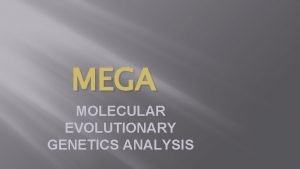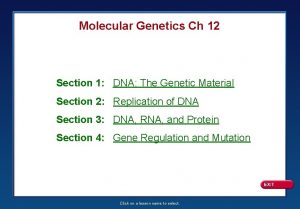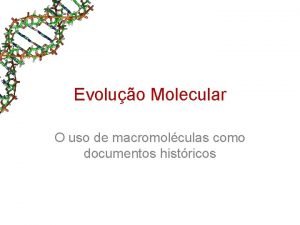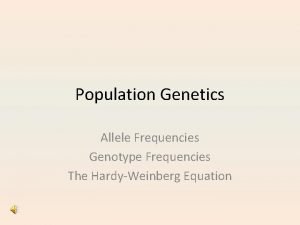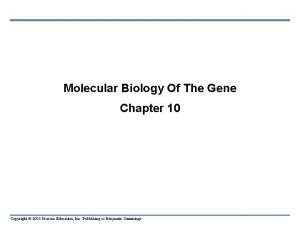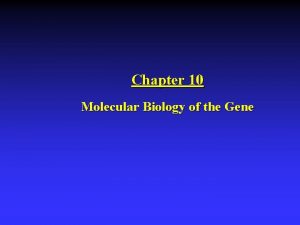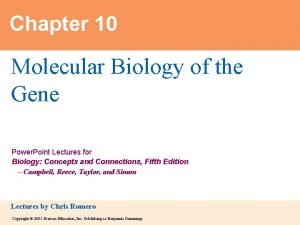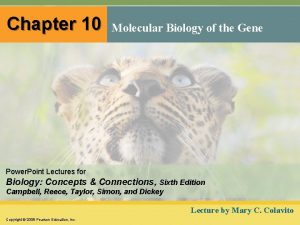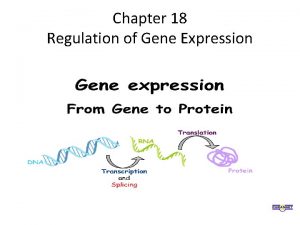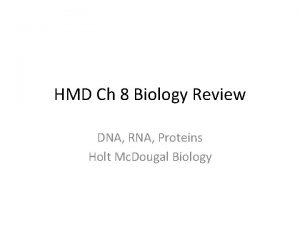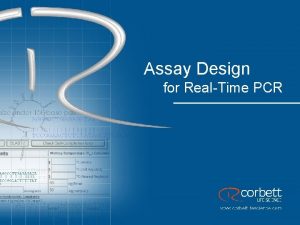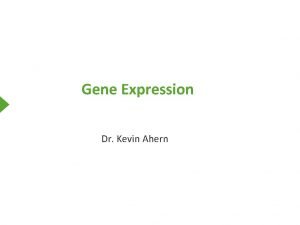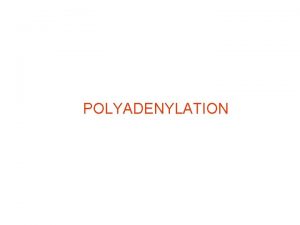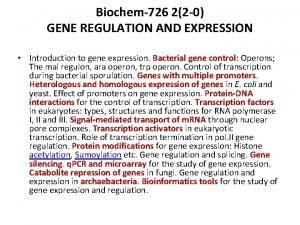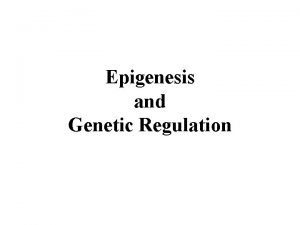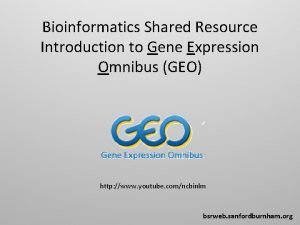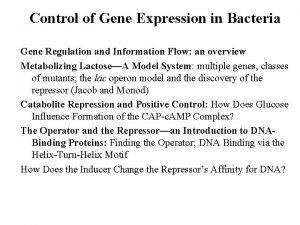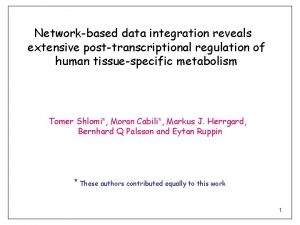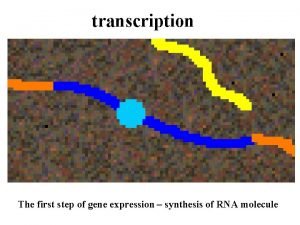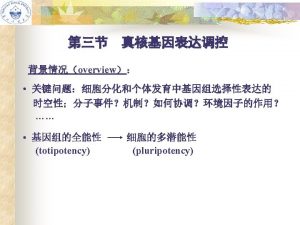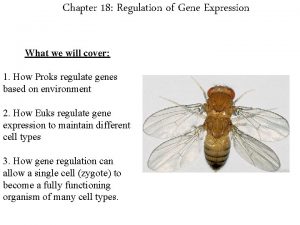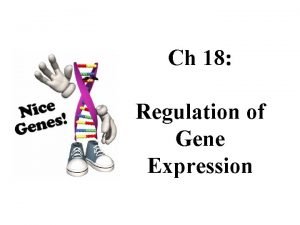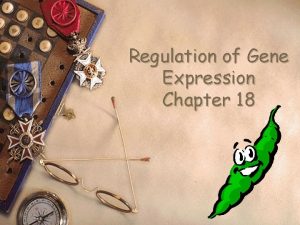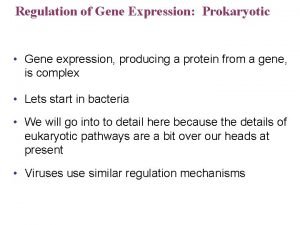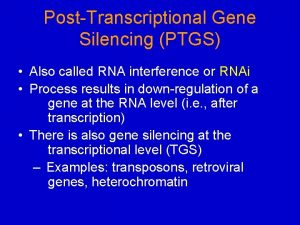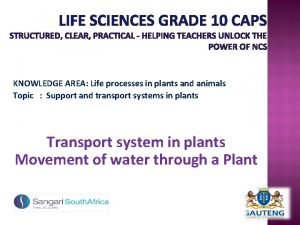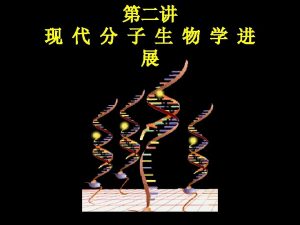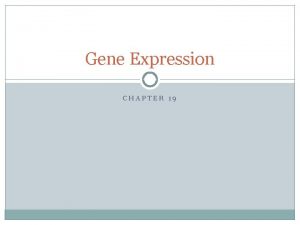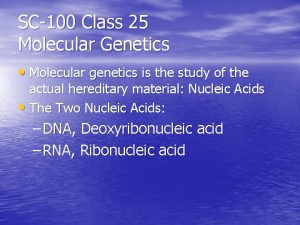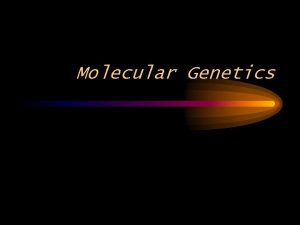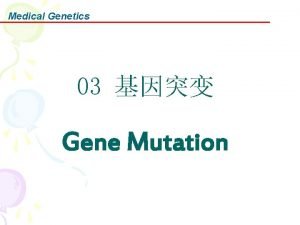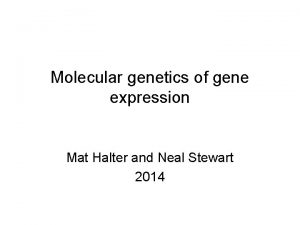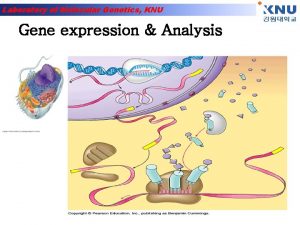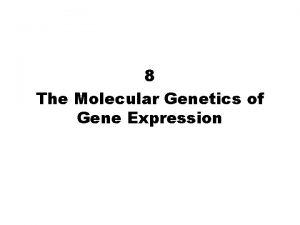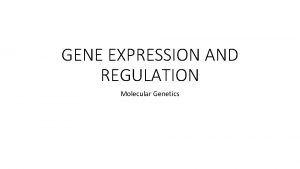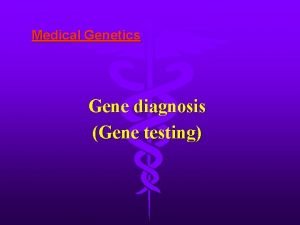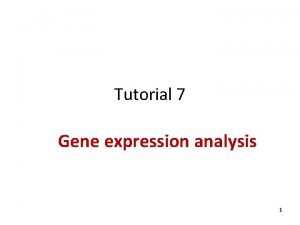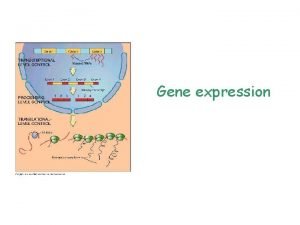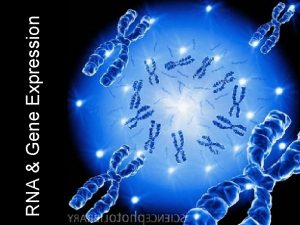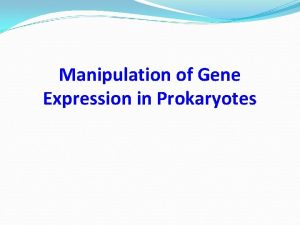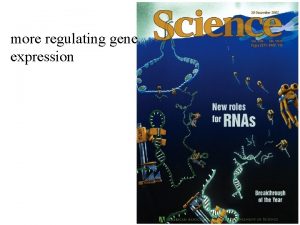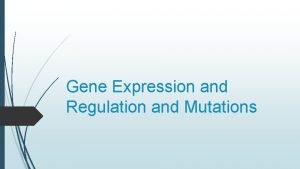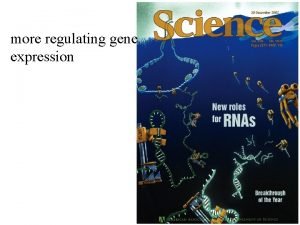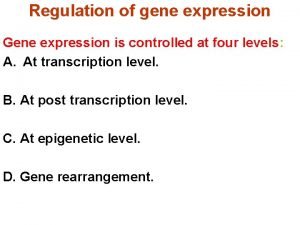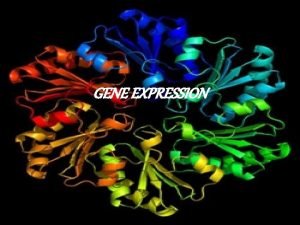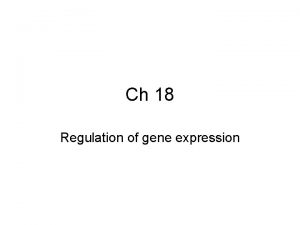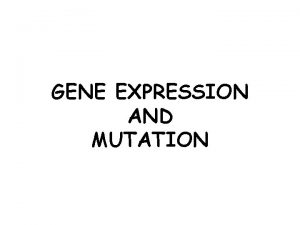Gene Expression Molecular Genetics March 2018 Gene Expression













































- Slides: 45

Gene Expression Molecular Genetics, March, 2018

Gene Expression – Control of Protein Levels – Bacteria Lac Operon Promoter – m. RNA – Inducer – CAP – Control – Trp Operon Repressor. Operator Control – Attenuation – Riboswitches –

Eukaryotes Scheme Chromatin Organization – Histones – Nucleosome –

Epigenetics Histone Modifications – Study – DNA Methylation – Transcriptional Control Enhancers – Transcription Factors – DNA Bending – Insulators –

Iron Metabolism Regulation IRE – Ferritin Regulation – Transferrin Receptor Regulation – RNA Interference si. RNA mi. RNA – Argonaut Activity – Translation Inhibition – Benefits –

Gene Expression

Gene Expression Controls on Protein Levels Transcription Splicing Polyadenylation m. RNA Stability Translation Protein Stability

Transcription Control - Prokaryotic Promoter

Transcription Control - Prokaryotic Promoter Polycistronic Message in Prokaryotes

Transcription Control - Prokaryotic Promoter Allo-Lactose

Transcription Control - Prokaryotic Promoter

Transcription Control - Prokaryotic Promoter

Transcription Control - Prokaryotic Promoter CAP c. AMP CAP Site of DNA

Transcription Control - Prokaryotic Promoter From Wikimedia Commons

Prokaryotic Transcription Control - Termination/Attenuation From Wikimedia Commons

Prokaryotic Transcription Control - Termination/Attenuation

Transcription/Translation Control - Riboswitches Cis-acting sequences Anti-terminator Terminator

Transcription/Translation Control - Riboswitches Lysine Bound to Riboswitch

Eukaryotic Gene Expression • Much More Complexity • Chromatin • Many Transcription Factors • Enhancers

Transcriptional Control - Eukaryotes

RNA Eukaryotic Gene Expression - Chromatin • Chromatin is the Complex of DNA, Protein, and RNA Comprising Eukaryotic Chromosomes For RNA Polymerase to Perform Transcription, Access Must Be Gained to the DNA Increasing Magnification

RNA Eukaryotic Gene Expression - Epigenetics •

RNA Eukaryotic Gene Expression - Chromatin • A Nucleosome is a Fundamental Unit of Chromatin Structure Contains Two Copies Each of Four Histone Proteins - H 2 a, H 2 B, H 3, and H 4 DNA is Wrapped Around this Octet Core and Histone H 1 is on the Outside

RNA Eukaryotic Gene Expression - Chromatin • Histone Proteins Are Rich in Basic Amino Acids, Making Them Positively Charged The Positively Charged Proteins Are Attracted Strongly to the Negatively Charged Phosphates of the DNA Chemical Modifications That Affect These Charges Influence Transcription

RNA Eukaryotic Gene Expression - Chromatin •

RNA Eukaryotic Gene Expression - Chromatin • • Histone Acetyl Transferases (HATs) Use Acetyl-Co. A to Put Acetyl Groups on Lysines in Histones • This Neutralizes Their Positive Charge and Loosens Interactions With the Histones, Facilitating “R • Acetylated Lysines Can Also be Binding Targets for Proteins Affecting Transcription n l a c i em atio c i f i od M Ch Unwinding of Complex

RNA Eukaryotic Gene Expression - Epigenetics •

RNA Eukaryotic Gene Expression - Chromatin • • Histone Acetylation Favors Euchromatin and Stimulates Transcription • Histone De-Acetylases Reverse These Effects, Favoring Heterochromatin and Gene Silencing • The Sirtuin 1 deacetylase in humans down-regulated with insulin resistance • Numerous Chemical Modifications are Made to Histone Proteins • Acetylation / Deacetylation • Methylation / Demethylation • Phosphorylation / Dephosphorylation • Ubiquitination • Chemical Modification to Bases in DNA Can Also Affect Transcription Open and Accessible to Transcription Complex Condensed and Not Accessible

RNA Eukaryotic Gene Expression - Epigenetics •

Epigenetics • Chemical Modifications in Histones and DNA Can Cross Generational Barriers • Transcriptional Effects Can Thus Be Transmitted From Parent to Progeny Independent of the Sequence of the DNA. • Such Influences are Called Epigenetic

Epigenetics Patterns of modification of chromosomes cross generational barriers. Genetic Imprinting Överkalix study 1. A greater body mass index (BMI) at 9 years in sons, but not daughters, of fathers who began smoking early. 2. The paternal grandfather's food supply was only linked to the mortality RR of grandsons and not granddaughters. 3. The paternal grandmother's food supply was only associated with the granddaughters' mortality risk ratio. The estimation of the percentage of human genes subject to parental imprinting is approximately one to two percent, currently parental imprinting has been identified in fewer than 100 distinct named genes.

Transcriptional Control - Eukaryotes Methylation of Cp. G sequences in eukaryotes inhibits transcription

Transcriptional Control - Eukaryotes


Transcriptional Control - Eukaryotes

RNA Eukaryotic Gene Expression - Transcription • Blocking Insulators Allows Enhancer to Activate Transcription Insulators Can Block Enhancer’s Activation of Transcription

Iron Transfer & Storage Ferritin - Cellular Protein to Bind Iron Transferrin Receptor - Membrane Protein to Transfer Iron

Iron Transfer & Storage Iron Response Element (IRE) Iron Response Element Binding Protein (IRE-BP)

Iron Transfer & Storage - Translation Regulation

Iron Transfer & Storage - m. RNA Stability

RNA Interference • • RNA Interference is a Powerful Means of Controlling Gene Expression • Viral and Endogenous Cellular Genes Are Targets • A Similar System Called pi. RNA (piwi RNA) Protects Against Transposon Genes • Considerable Interest in Using Technique to Genetically Transform Organisms for Protect Against Pathogens

Cellular Source RNA Cellular Pre-Processing RNA Interference • Transcription Double-Stranded RNA is Stimulus Processing Viral Infection 20 bp pieces RISC Target Complementary Sequences in m. RNAs

RNA Interference • Complementary Sequences Align RISC + Argonaute Activity in RISC Breaks m. RNA, Stops Translation m. RNA Translation of m. RNA Stopped + RISC

RNA • • • RNA Interference • Protection Against Invading Viruses Stimulated by ds. RNA mi. RNA (cellular) & si. RNA (foreign) Cellular piwi RNAs (pi. RNA) have similar functions in silencing transposons Widespread in Eukaryotes Actions referred to as RNA Interference (RNAi) RNA Interference Operates Through the Silencing of Gene Expression DS RNA induces Dicer to chop it into 20 BP Pieces These si. RNAs/mi. RNAs bind to the RNA Induced Silencing Complex (RISC) One Strand is Destroyed and One Retained to Bind to Complementary m. RNA sequences • RISC Nuclease Activity (Argonaute) • 1. Destroys m. RNA Where Strand Binds or • 2. si. RNA/mi. RNA strand on m. RNA blocks translation or • 3. si/RNA/mi. RNA strand destabilizes m. RNA and Targets for Destruction

RNA Interference • Bonding to m. RNA Premature Stopping of Translation Degradation of m. RNA
 Chapter 17 from gene to protein
Chapter 17 from gene to protein March march dabrowski
March march dabrowski Azure bug bounty
Azure bug bounty Molecular evolutionary genetics analysis download
Molecular evolutionary genetics analysis download Molecular genetics chapter 12
Molecular genetics chapter 12 14-3 human molecular genetics
14-3 human molecular genetics Parent genotype
Parent genotype Chapter 12 section 1: dna: the genetic material
Chapter 12 section 1: dna: the genetic material Arvore filogenetica
Arvore filogenetica Chapter 12 section 1 molecular genetics answer key
Chapter 12 section 1 molecular genetics answer key Molecular genetics section 1 dna the genetic material
Molecular genetics section 1 dna the genetic material Genotype vs allele frequency
Genotype vs allele frequency Giant molecular structure vs simple molecular structure
Giant molecular structure vs simple molecular structure What is a covalent bond simple definition
What is a covalent bond simple definition Giant molecular structure vs simple molecular structure
Giant molecular structure vs simple molecular structure Molecular biology of the gene chapter 10
Molecular biology of the gene chapter 10 Chapter 10 molecular biology of the gene
Chapter 10 molecular biology of the gene Chapter 10 molecular biology of the gene
Chapter 10 molecular biology of the gene Molecular biology of the gene chapter 10
Molecular biology of the gene chapter 10 Gene by gene test results
Gene by gene test results B a f c j e
B a f c j e Chapter 18 regulation of gene expression
Chapter 18 regulation of gene expression At dna
At dna Intron pcr
Intron pcr Genetic effects on gene expression across human tissues
Genetic effects on gene expression across human tissues Gene expression:
Gene expression: Gene expression
Gene expression Regulation of gene expression
Regulation of gene expression Lyonization of gene expression
Lyonization of gene expression Gene expression omnibus tutorial
Gene expression omnibus tutorial Regulation of gene expression
Regulation of gene expression Gene expression
Gene expression טרנסלציה
טרנסלציה Positive vs negative gene regulation
Positive vs negative gene regulation Gene expression
Gene expression Chapter 18 regulation of gene expression
Chapter 18 regulation of gene expression Lac operon inducible or repressible
Lac operon inducible or repressible Chapter 18
Chapter 18 Chapter 18 regulation of gene expression
Chapter 18 regulation of gene expression Operon lac
Operon lac Gene expression
Gene expression Quadratic equation examples
Quadratic equation examples March 22 2010
March 22 2010 Sun yat sen nasyonalismo
Sun yat sen nasyonalismo Performance art
Performance art In march
In march



